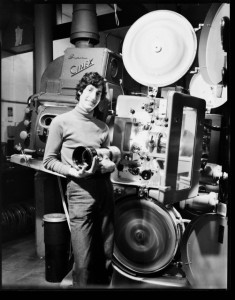 |
Why is Anamorphic Projection Chosen over Zooming in High End Home Theaters?
If your home theater is primarily for movies and streaming content then you’ll want the 2.4:1 cinema format screen of a commercial theater (you may have heard of 2.35:1 but that is an older format from before 1972). Letterbox zooming refers to using the projector’s lens memory settings for zoom, shift and focus to zoom up a letterbox movie to fill your cinema-format screen, while then zooming back down to place 16:9 content in the center of that screen with black on the left and right. This approach is an economical way to keep the black bars of cinema-format movies and most streaming content off the screen by projecting them onto the walls above and below. Almost every high end home theater projector has this capability and yet every high end home theater projector also has the anamorphic modes for using an external Panamorph lens. Which should you choose, and why?
Let’s start with the bottom line: Anamorphic cinema-format projection dramatically improves the brightness and clarity – the visual performance – of your entire home theater movie experience. That’s really what this all boils down to – performance. After all, your video image is the visual focal point your cinema is built around. If you’ve got a 4K projector then you want to be using that entire 4K for the largest movies – not just the 3K performance you get with letterbox zooming (since 1K is used to create the black bars on the walls). But of course pure performance is just the big picture. Here are eleven reasons why thousands of high end home theaters have Panamorph lenses installed …
The Top Eleven Reasons
1. 30% greater brightness. A big cinema-format screen needs a bright, high contrast image for the most impact from today’s movies. It’s that simple. Even with typical optical losses, using the 33% extra pixels of your projector with a CDR lens gives you around 30% actual additional light on your screen (38% with a DCR lens) compared to a zoomed-up letterbox image, delivering the absolute best experience from major motion pictures and especially that critical boost for today’s HDR content.
2. 33% greater picture detail. If there’s one thing that has been proven with today’s image processing technology it’s that more pixels can lead to dramatic improvements in picture quality (yes, even if the original content has limited resolution). For example, it’s well known that Ultra HD displays with upconverted HD Blu-ray movies look almost as good as the original Ultra HD movie content itself. The same applies to upconverting letterbox movies with 33% more vertical pixels. Those pixels (over 2 million from a 4K projector) represent greater flexibility and potential for image processing algorithms to make the image look as good as it possibly can.

An anamorphic projection system lets you watch even HDTV content in the full cinema format.
3. You can now watch ALL today’s content with maximum performance to fill your screen 100% of the time with no black areas at all. You may have not seen this one coming, but many people use an anamorphic lens to watch smaller format movies and HDTV content stretched out to fill their cinema-format screens. It’s actually a very simple thing to do. Just input any 1080p or 4K (UHD) content to your projector and include the anamorphic lens. Absolutely no electronic processing is required. The anamorphic lens effectively stretches the full image out to almost or completely fill the screen. And if that’s not the look you prefer then you also have the option of turning on the anamorphic mode to crop a bit off the top and bottom of the image so that the image looks completely normal. And of course, you still have the option of watching smaller content, well, smaller – with black “pillar boxes” on the sides – at the push of a button. But these first two options mean you can get the immersive impact of the cinema-format experience even with all today’s movies and any HDTV content from sports to entertainment. To see these options in action check out the How to Watch 16:9 Content in a Cinema-Format Home Theater article.
4. Convenient menu visibility. If you use the zoom method to watch cinema-format content, any menus brought up by the player (such as pause, scene change, etc.) or projector will partially show off the screen and on the wall above and below, making them difficult to see. To bring the full menu onto the screen means the projector needs to be zoomed down each time the menu is engaged and then zoomed back up to frame the content on the cinema-format screen, often taking 5-10 seconds each way just to use a menu feature. With anamorphic projection this is much simpler because it’s immediate: Just turn the anamorphic mode off using the remote and the entire menu will be instantly visible.
5. Less noticeable pixel structure. The reason you chose projection for your home theater is to go large, but the larger you go the more you can see the individual pixels that make up the image. In reality, it’s primarily the vertical dimension of the pixels that we notice the most because video content has more horizontal motion. As an example, if you create an cinema-format image on a 48” (1.22M) high screen with an HD projector, you are only using 810 rows of pixels for a pixel height of about 1.5mm. Alternatively, the full 1080 pixels provided by the anamorphic approach on that same screen are much less visible at a height of only 1.1mm.
6. Knowing you’re using the full performance of your projector. While this is somewhat overlapped with the other reasons, there’s just something “right” about seeing major motion pictures with the full performance of your projector rather than restricting them down to 75% of that performance. It’s like driving a car at the peak of its torque curve and knowing you’re not riding the brakes at the same time. Everybody is talking about 4K these days. You paid for a full 4K projector. It’s just not right getting 3K from your 4K investment when you’re watching blockbuster movies on your cinema-format screen.
7. No unnecessary heat build-up in the projector. If you are zooming up a letterbox image then all those pixels used to create the black bars on the wall above and below a cinema-format screen aren’t actually turned off. In reality they’re set to “black” by absorbing 25% of the lamp’s full intensity inside the projector and turning it into heat. Of course, since anamorphic projection uses those pixels to form the image then this unnecessary heat build-up is eliminated.
8. Instant format changes and no moving parts. These days most anamorphic projection systems operate with a fixed anamorphic lens so that no mechanical adjustments are ever needed after installation. On the other hand, letterbox zooming requires adjustment of zoom, lens shift and sometimes even focus every time the content aspect ratio changes from cinema to smaller formats (including those times you need to see the full menu), creating mechanical wear that may require periodic maintenance, especially if the image is no longer returning precisely to its programmed configuration with each change.
9. Greater projector setup flexibility. Using a zoom lens with a cinema-format screen means one zoom setting is used to fill the height of the screen for 16:9 content and then another zoom setting is used to fill the width of the screen for cinema-format content. The projector must therefore be installed in a position where both these zoom settings are within the available zoom range of the projector at that position. With a fixed Paladin lens your projector only needs to fill the width of your screen for all content so there is a much greater range of possible installation locations.
10. No pixels wasted on your walls. Many of today’s projectors can project the black bars above and below your cinema-format screen so black that only a ghost of those bars remains. But since anamorphic projection puts ALL your projector’s pixels on the screen the purist in us loves knowing there will never be ANY type of black bars on our walls, ghost or otherwise.
 11. Your cinema is a real cinema. Most movies created in the past 50+ years were both filmed and projected using anamorphic lenses to provide the maximum performance in commercial theaters. Their use in home cinemas was directly inspired by this same use in the motion picture industry. It’s nice to know that your home cinema uses projection technology that goes all the way back to the Golden Age of Hollywood.
11. Your cinema is a real cinema. Most movies created in the past 50+ years were both filmed and projected using anamorphic lenses to provide the maximum performance in commercial theaters. Their use in home cinemas was directly inspired by this same use in the motion picture industry. It’s nice to know that your home cinema uses projection technology that goes all the way back to the Golden Age of Hollywood.
BONUS. Buy the best lens just once. Full size CDR and DCR lenses are rated to full 8K pixel resolution, meaning they are likely )although not guaranteed) to work with a future projector of the same 16:9 or 17:9 format. That means you probably don’t need to buy a new lens with each projector. Naturally the attachment hardware may need to be upgraded but the lens itself will probably last you until your own Golden Years.
